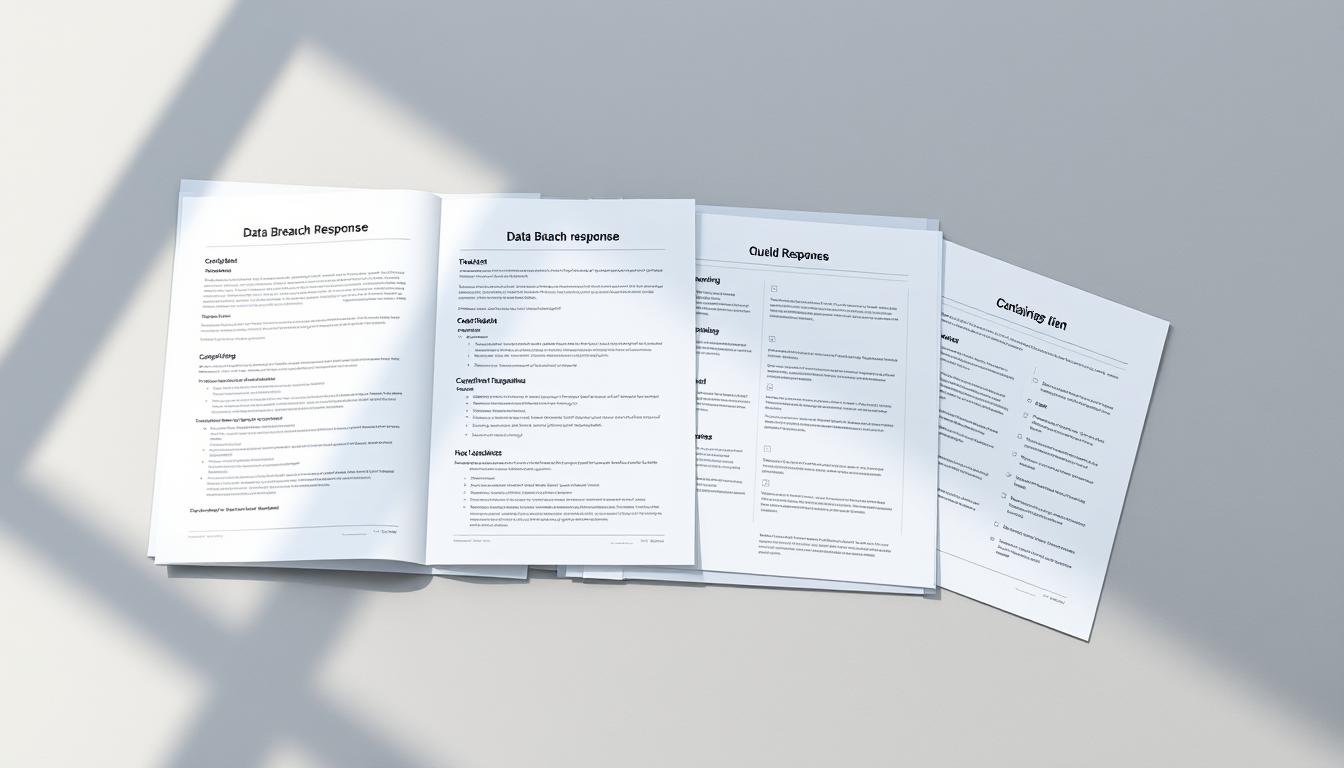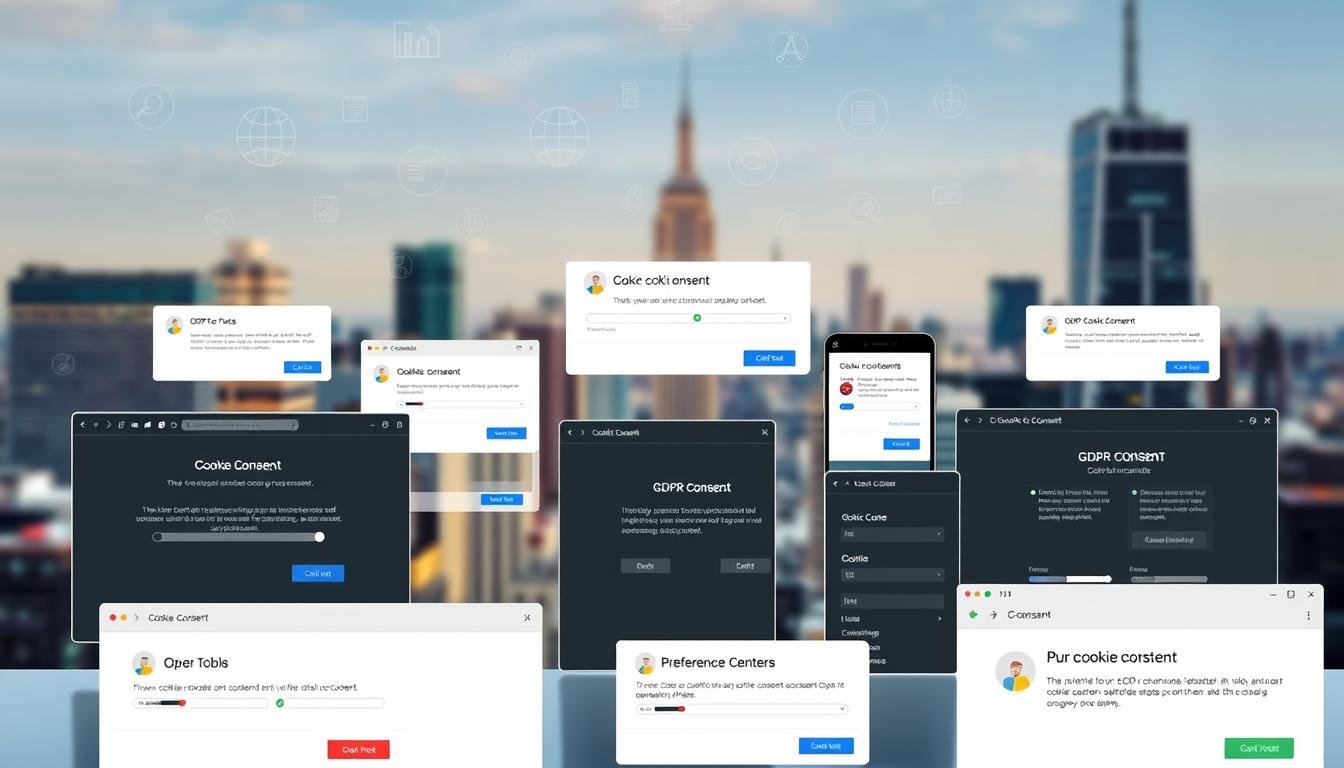What if your organization faced a cybersecurity incident tomorrow? Would you know how to respond effectively? With 68% of businesses experiencing such incidents within a year, being unprepared is not an option. A structured approach is essential to minimize damage and maintain compliance.
This guide introduces a data breach response template to help you create a customized plan. Tools like JusTech’s legal app and Gavel Exec’s AI-powered document assistant make drafting policies easier. These resources ensure your plan adapts to different industries and regulatory environments.
Ignoring preparedness can be costly. The average cost of an incident has reached $4.45 million in 2023. A well-designed template not only saves money but also protects your reputation. Let’s explore how you can build a robust response strategy.
Key Takeaways
- 68% of businesses face incidents within 12 months.
- JusTech and Gavel Exec offer tools for drafting policies.
- Customizable templates ensure compliance across industries.
- The average cost of an incident is $4.45 million.
- Preparation minimizes financial and reputational risks.
Introduction to Data Breach Response
In today’s digital landscape, cyber threats are evolving faster than ever. Organizations face risks like ransomware, phishing, and insider threats. These attacks can cripple operations and expose sensitive information.
The first 72 hours after an incident are critical. Quick action can reduce the severity of the impact. Delays often lead to higher costs and reputational damage.
Compliance with regulations like CCPA, HIPAA, and GDPR is essential. These laws require businesses to protect customer data and report incidents promptly. Failure to comply can result in hefty fines.
Take the Equifax case as an example. Their 2017 breach exposed millions of records and led to a $700 million settlement. This highlights the importance of proper planning and execution.
Preserving digital forensics evidence is another key step. This helps identify the cause and scope of the incident. It also supports legal and regulatory investigations.
Clear communication with stakeholders is vital. Establish a hierarchy to ensure accurate and timely updates. This builds trust and minimizes confusion during a crisis.
Why You Need a Data Breach Response Template
Without a clear strategy, handling a cyber incident can spiral out of control. A well-defined plan ensures your company can act swiftly and effectively. Without it, the fallout can be devastating.
According to the Ponemon Institute, 77% of organizations without response plans experience longer downtime. This delay can lead to significant financial losses and operational disruptions.
The Consequences of Not Having a Plan
Financial penalties are a major risk. The FTC can impose fines of up to $43,792 per violation. These costs can quickly add up, especially for larger organizations.
Reputational damage is another critical concern. Studies show that 33% of customers leave a company after a security incident. Rebuilding trust takes time and resources.
Operational disruptions are costly. Hourly downtime averages $8,662, impacting productivity and revenue. Legal exposure is also a risk, as seen in class action lawsuits against Yahoo and Target.
Compliance failures can lead to severe repercussions. For example, OCR HIPAA penalties have exceeded $1.5 million. Insurance complications, such as claim denials, further compound the problem.
Having a robust planning framework in place is essential. It minimizes risks and ensures your organization is prepared to handle any security event effectively.
Key Components of a Data Breach Response Template
When a security incident occurs, having a structured plan is crucial. A well-designed framework ensures your organization can act swiftly and effectively. Tools like JusTech and Gavel Exec provide essential resources to streamline this process.
Breach Notification Policy
A breach notification policy is a critical part of any plan. It outlines how and when to inform affected parties. Key elements include the scope of the incident, remediation steps, and timelines for communication.
For example, JusTech’s template includes 14 sections to ensure compliance. This covers everything from mandatory notifications to detailed documentation requirements. Gavel Exec’s auto-generated role matrices further simplify the process.
Incident Response Team Roles
Clear roles and responsibilities are essential for effective handling. A typical team includes a CISO, Legal Counsel, PR Lead, and IT Specialist. Each member plays a vital role in managing the situation.
Escalation protocols should also be defined. This ensures executive leadership or board members are involved when necessary. Proper documentation, such as chain of custody forms and access logs, supports legal and regulatory investigations.
Integration with existing frameworks, like NIST SP 800-61, enhances the plan’s effectiveness. Customization is key—healthcare and retail sectors, for instance, have unique requirements.
Steps to Create Your Data Breach Response Template
Creating a robust framework for handling security incidents is essential for any organization. A well-designed plan ensures you can act swiftly and minimize risks. Start by evaluating your current setup and tailoring the framework to your specific needs.
Assessing Your Current Security Measures
Begin with a thorough review of your existing protocols. Tools like Gavel Exec can analyze your documents to identify compliance gaps. This step helps you understand where improvements are needed.
Develop a risk assessment matrix to classify sensitive information. This system ensures you prioritize critical areas. Vendor management protocols are also crucial, especially for third-party breaches.
Customizing the Template to Fit Your Needs
Tailor the framework to align with your industry and company size. Use a customization checklist to address specific regulations. For example, healthcare and retail sectors have unique requirements.
Integrate your technology stack, such as SIEM systems and IAM solutions. This ensures seamless coordination during an incident. Version control systems also help maintain accurate audit trails.
Finally, practice your plan through tabletop exercises. Simulated phishing attack scenarios prepare your team for real-world situations. Regular drills ensure everyone knows their role and responsibilities.
Using Legal Apps to Generate Compliance Documents
Legal apps are transforming how businesses handle compliance, offering speed and accuracy like never before. These tools simplify the process of creating essential documents, saving time and reducing errors. With the increasing complexity of regulations, having a reliable solution is more important than ever.
For example, JusTech’s app can generate 23 compliance documents in under 15 minutes. Similarly, Gavel Exec reduces drafting time by 70%. These apps are designed to use advanced technology to streamline workflows and ensure accuracy.
Benefits of Using Legal Apps
One major advantage is automated regulatory updates. Apps like JusTech and Gavel Exec track changes in laws like CCPA and HIPAA in real-time. This ensures your documents are always up-to-date without manual effort.
Another key feature is document version comparison. Redline functionality allows you to see changes between policy updates clearly. This is especially useful for maintaining compliance during audits.
Workflow integration is another standout benefit. These apps can be configured to send alerts through platforms like MS Teams or Slack. This ensures your team stays informed and can act quickly when needed.
Audit trail generation is also automated. Change logs are created for every update, providing a clear record for compliance audits. This reduces the risk of errors and ensures transparency.
Cost savings are significant too. On average, businesses save $8,000 compared to traditional legal services. Additionally, these apps come with security certifications like SOC 2 Type II, ensuring your data is protected.
By leveraging these tools, businesses gain valuable insights into their compliance processes. This not only improves efficiency but also reduces the risk of non-compliance penalties.
Best Practices for Implementing Your Data Breach Response Plan
Effective implementation is the backbone of any security plan. Without proper execution, even the most detailed framework can fall short. To ensure your strategy works in real-world scenarios, focus on two critical areas: regular training and continuous improvement.
Regular Training and Drills
Training is essential to keep your team prepared. Conduct quarterly briefings for C-suite executives and bi-annual drills for staff. This ensures everyone understands their roles and responsibilities.
Phishing simulations are a great way to test awareness. Track click rates and use the insights to improve training programs. Reducing click rates over time shows progress in your team’s readiness.
Continuous Improvement and Updates
Security is not a one-time effort. Regularly review and update your plan to address new threats. Use a semantic numbering system (e.g., v2.1.3) for version control to track changes effectively.
Post-mortem analysis is crucial after any incident. Identify root causes and update your planning framework accordingly. This helps prevent similar issues in the future.
Third-party validation, like annual penetration testing, ensures your defenses are strong. Additionally, review your technology stack every 18 months to keep it up-to-date.
By following these practices, your company can stay ahead of threats and protect sensitive information effectively.
Resources for Downloading Data Breach Response Templates
Accessing reliable resources for security planning is easier than ever. Organizations can now find professional-grade tools to enhance their preparedness. These templates are designed to simplify the process and ensure compliance with regulations.
Free and Lawyer-Backed Templates
Many platforms offer free and lawyer-reviewed documents to help businesses get started. For example, JusTech provides GDPR/CCPA-compliant templates, while Gavel Exec offers AI-powered drafting tools. These solutions are tailored to meet industry-specific needs.
Key features include a template comparison matrix, highlighting free vs. premium options. A 3-stage lawyer review process ensures accuracy and reliability. Formats like DOCX, PDF, and Markdown make it easy to integrate these templates into your workflow.
Version histories allow access to updates from the past five years. Sector-specific packs, such as Healthcare, FinTech, and EdTech bundles, cater to unique requirements. Integration guides for MS 365 and Google Workspace ensure seamless implementation.
Conclusion
Protecting your organization from security risks requires proactive planning and execution. Start with a 30-day implementation roadmap to prioritize critical actions. Ensure compliance by tracking key regulatory filing deadlines using a calendar tailored to your industry.
Partner with trusted technology providers, such as CRN’s top 20 MSSPs, to strengthen your defenses. Regularly review your template and processes quarterly to address evolving threats. Use an executive summary framework to keep leadership informed and aligned.
Finally, assess your readiness with a self-assessment matrix. This tool helps identify gaps and ensures your notification and communication strategies are effective. By following these steps, you can safeguard sensitive information and minimize risks effectively.







